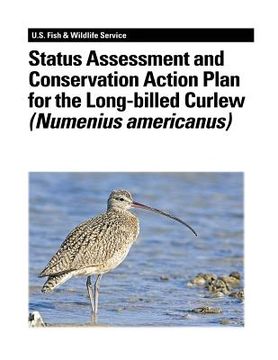Status Assessment and Conservation Action Plan for the Long-billed Curlew (Numenius americanus) (en Inglés)
Reseña del libro "Status Assessment and Conservation Action Plan for the Long-billed Curlew (Numenius americanus) (en Inglés)"
The historical breeding range of Long-billed Curlews (Numenius americanus) was the western U.S. and the southern Canadian Prairie Provinces from California north to British Columbia and east to southern Manitoba and Wisconsin, northern Iowa and eastern Kansas. However, this breeding distribution has contracted and Long-billed Curlews have lost about 30% of their historical range. The eastern edge of the current breeding range is the western Great Plains from the Texas panhandle north throughout southwestern and south central Saskatchewan. Long-billed Curlews currently winter along the southwestern U.S. coast from central California, southern Texas and Louisiana south along both of México's coasts to Guatemala, and are casual along the Atlantic coast north to New Brunswick, the southeastern South Carolina and Florida coasts, and the West Indies. Long-billed Curlews are federally protected in the U.S., Canada, and México under the Migratory Bird Treaty Act. In the U.S., they are listed as a U.S. Fish and Wildlife Service Bird of Conservation Concern: nationally, in five U.S. Fish and Wildlife Service regions, and in several Bird Conservation Regions. They are listed as a species of concern in several U.S. states. In Canada, they are on Schedule 1 of the Species at Risk Act as a "Species of Special Concern" and are "Blue Listed" in Alberta and British Columbia. In addition, they are listed as "Highly Imperiled" in both the U.S. and Canadian shorebird conservation plans. Long-billed Curlews are a protected migratory bird species but do not have an official conservation designation in México. The high levels of concern are due to the loss of the eastern third of their historical breeding range and apparent population declines, particularly in the shortgrass and mixed-grass prairies of the western Great Plains. The Breeding Bird Survey does not show any significant trends for Long-billed Curlews throughout much of their range; however, the applicability of BBS to adequately monitor Longbilled Curlews has been questioned. Documented declines have occurred in several portions of their range, including historical population declines, the contraction of breeding range, and reductions in the number of migrants along the Atlantic coast. Initial population declines were attributed to over-hunting and plowing of the native prairies for agriculture. Current threats include habitat loss and destruction due to urban development, grassland conversion for agricultural purposes, changes in the natural fire regime and the spread of exotic invasive species. Predation, grazing practices, energy development, diseases, and pesticides may also threaten Longbilled Curlew populations. Long-billed Curlews breed, migrate, and winter across multiple geographical ranges; therefore, effective conservation actions will require cooperation by local, regional, and international entities. Several important steps have been taken towards identifying limiting factors affecting Longbilled Curlew populations. Current conservation needs include: population monitoring, breeding ground studies that identify local micro-habitat use, and identification of critical wintering and migration areas. The development and use of management recommendations for maintaining native grasslands, invasive species control, and water and wetland conservation are also important to the maintenance of Long-billed Curlew populations. Investigation of the effects of energy development and subsequent operations is increasingly important as the demand for alternative "green" energy sources increases. Public outreach will continue to be an important tool in the conservation of Long-billed Curlew populations. Currently, while there are very few specific Long-billed Curlew management and conservation projects on-going, there are many identified needs. This status assessment and conservation action plan is intended to be a summary of the current state of the species, and a guide to its conservati

